We compare the thermal conductance of circular GALs with ![]() and different radii, including Circ(10,24), Circ(10,108) and
Circ(10,258). The phonon density of states (DOS) and phonon
transmission of these GALs are shown in Fig. 3.15. As
indicated in Table 3.2, by increasing the size of the
antidot, the phonon DOS, the phonon transmission, and the thermal
conductance are significantly reduced. In Fig. 3.16
two phonon modes of Circ(10,108) at the
and different radii, including Circ(10,24), Circ(10,108) and
Circ(10,258). The phonon density of states (DOS) and phonon
transmission of these GALs are shown in Fig. 3.15. As
indicated in Table 3.2, by increasing the size of the
antidot, the phonon DOS, the phonon transmission, and the thermal
conductance are significantly reduced. In Fig. 3.16
two phonon modes of Circ(10,108) at the ![]() point are
shown. Fig. 3.16-a presents a localized phonon mode
as a result of introducing antidots, whereas,
Fig. 3.16-b shows a propagative mode. By introducing
antidots into the graphene sheet, some phonon modes become localized,
similar to electrons, and they can not contribute to the thermal
conductance.
point are
shown. Fig. 3.16-a presents a localized phonon mode
as a result of introducing antidots, whereas,
Fig. 3.16-b shows a propagative mode. By introducing
antidots into the graphene sheet, some phonon modes become localized,
similar to electrons, and they can not contribute to the thermal
conductance.
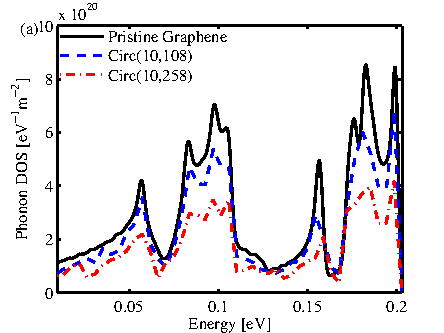
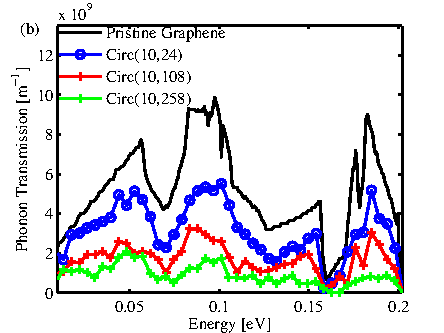
|
To investigate the effect of the antidot circumference, we compare
GALs with nearly the same area and different shapes, including
Circ(10,108), Rect(10,120), Hex(10,120), IsoTri(10,126), and
RightTri(10,126). Although the DOS of these GALs have the same order
as that of a pristine graphene sheet, the transmissions
can be very different. Fig. 3.17-a shows that
the phonon transmissions of Circ![]() and
Rect
and
Rect![]() are quite different from that of pristine
graphene. However, Circ
are quite different from that of pristine
graphene. However, Circ![]() , Rect
, Rect![]() , and Hex
, and Hex![]() have nearly the same transmissions, whereas
IsoTri
have nearly the same transmissions, whereas
IsoTri![]() and Right
and Right![]() have similar transmissions which
are different from the first group, see
Fig. 3.17-b.
have similar transmissions which
are different from the first group, see
Fig. 3.17-b.
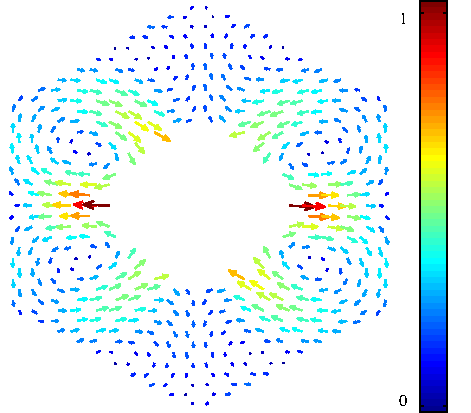
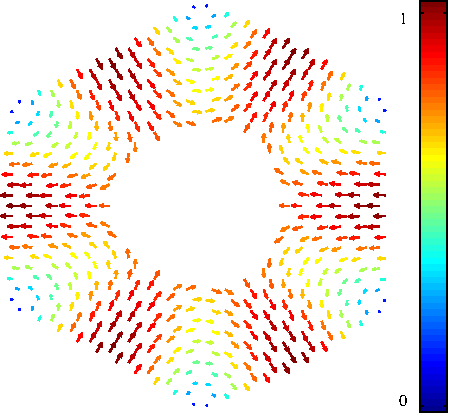
|
The transmissions of Circ![]() , Rect
, Rect![]() , and Hex
, and Hex![]() are similar because they have similar circumference and thus the same
number of boundary carbon atoms. Furthermore, the nearest-neighbor
dots in these GALs have nearly the same distance. On the other hand,
IsoTri
are similar because they have similar circumference and thus the same
number of boundary carbon atoms. Furthermore, the nearest-neighbor
dots in these GALs have nearly the same distance. On the other hand,
IsoTri![]() and RightTri
and RightTri![]() have the same circumference
which is different from those of the first group.
have the same circumference
which is different from those of the first group.
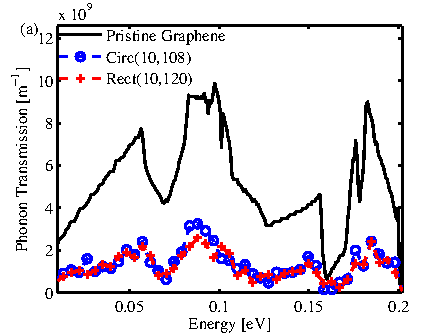
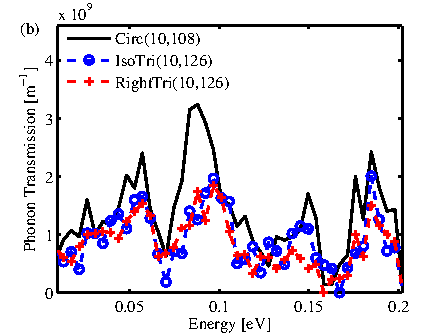
|
The thermal conductances of pristine graphene and different GALs are summarized in Table 3.2. Triangular GALs have the smallest thermal conductance, although they have the minimum area of all antidot shapes. This behavior can be explained by considering the fact that triangular antidots have the highest circumference of all antidots with the same area. This indicates that circumference of the antidot has a stronger effect on the thermal conductance rather than its area.